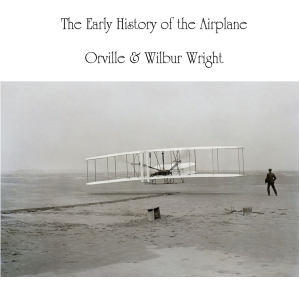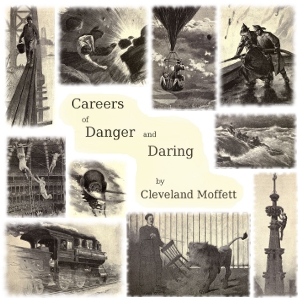The Brothers Orville and Wilbur Wright made the first controlled, powered and sustained heavier-than-air flight, on 17th December 1903. They were not the first to build and fly aircraft, but they invented the controls that were necessary for a pilot to steer the aircraft, which made fixed wing powered flight possible. The Early History of the Airplane consists of three short essays about the beginnings of human flight. The second essay retells the first flight: This flight lasted only 12 seconds, but it was nevertheless the first in the history of the world in which a machine carrying a man had raised itself by its own power into the air in full flight, had sailed forward without reduction of speed and had finally landed at a point as high as that from which it started. (Introduction by Availle)
3 episodes
In this volume of adventure the author depicts the lives of certain humble modern heroes whose unconscious courage ordinarily goes unnoticed. Mr. Moffett
has chosen unusual and picturesque careers, and has offered dramatic scenes from the lives of the steeple climber, the diver, the balloonist,the pilot, the bridge builder, the fireman, the aerial acrobat, the wild animal trainer, the dynamite worker and lastly the locomotive driver. (Summary by annise)And it has great pictures - ever wondered what the top of a steeple really looked like? Some listeners may find the "Wild Animal Tamer" stories distressing - I did. I would suggest you just don't download that section - the rest is well worth listening to.
40 episodes

Rawlings follows the development of printing from the origins of writing to modern printing. Some of the earliest records are ancient Egyptian, Greek and Roman recordings on papyrus and wax tablets. However, Rawlings acknowledges the sparse nature of this first fragile evidence, and limits speculation.
Later, libraries of religious books grew in Europe, where monks copied individual books in monasteries. The "block printing" technique began with illustrations carved in wood blocks, while the text needed to be written by hand. Eventually, entire pages were printed as combinations of illustrations with text. The Biblia Pauperum, or “Bible of the Poor,” demonstrates this first time saving method.
Later chapters focus on printing developing as an industry, especially after the invention of movable type. Two inventors are contested as the first inventor, Johann Gutenberg of Mentz in Germany, and Laurenz Coster of Haarlem in Holland. Rawlings describes the evidence for each side, along with stories and legends that grow around their names.
Since many of the medieval books were meant to be admired as art by the illiterate majority and read only by an educated minority, copiers spent much time decorating manuscripts. Also, these highly decorated volumes needed to be protected. Here, Rawlings describes the techniques for binding and beautifying books. Arriving closer to the present day, Rawlings describes a few modern printing techniques that bring mass produced and cheap books to the now literate public. (Summary by LivelyHive)
8 episodes
It is not impossible that some useful information may be conveyed by this book. Should these pages prove of such service, their cost in labor is most cheerfully donated.This volume is composed of a series of articles which appeared in a Trade Journal, covering a period of two years from 1887 to 1889. It must be accepted as but a brief history of an industry long identified with Baltimore.Thanks are due the Librarian of the Maryland Historical Society and Mr. B. R. Sheriff for favors in lending rare and valuable old City directories; also to the many citizens who kindly aided and assisted in the search for needed information.The Author. (from the Preface)
18 episodes
“… this war was not one of mere destruction. It set men to thinking as they had never thought before. It intensified their inventive faculties, and as a result, the world is richer in many ways. Lessons of thrift and economy have been taught us. Manufacturers have learned the value of standardization. The business man has gained an appreciation of scientific research. The whole story is too big to be contained within the covers of a single book, but I have selected the more important and interesting inventions and have endeavored to describe them in simple language for the benefit of the reader who is not technically trained.” Bond was the sometime editor of Scientific American magazine.
( Book Preface, David Wales)
17 episodes
These two publications put out by the U.S. government are about the Trinity site in New Mexico where in 1945 the first atomic bomb was tested. Each publication (about 1984 and about 1995) complements the other, though there is some duplication. These are descriptions of the test itself and of the planning and organization leading up to the test. They also tell what was done with the site after the test and how it became a national historic landmark. - Summary by david wales
2 episodes
This is a chronicle of the 19 most interesting inventions of the early 20th century. Some of the inventions are still in use and of considerable impact today, while others are examples of the strong belief in progress prevalent at the time would probably be frowned upon today. In this way, the author's account of how ice was made at the time will still be very interesting for readers today, but an account of how dynamite was going to be used in farming may be seen as humorous to the contemporary reader. The subjects are as varied as science herself is, and any reader and listener should find a subject matching his or her own taste. - Summary by Carolin
20 episodes
The electric telegraph, together with the railway-train and the steamship, constituted the three most conspicuous features of late 19th century civilization. Indeed, it may be truly said that the harnessing electricity to the service of man for human communication has effected a change in political, commercial, and social relations, even more complete than that wrought by steam locomotion. This is the story of how the electric telegraph cable was laid across the floor of the Atlantic from Newfoundland to Ireland. - Summary by modified from the introduction
20 episodes
This is a volume of exploration into the newest inventions of the turn of the previous century. Journalist Archibald Williams walks the reader through diverse inventions which were changing the world at just that point in time. - Summary by Carolin
22 episodes
As all but Martians know (and who knows, perhaps even they), the city of San Francisco, California, was destroyed by massive earthquake and unquenchable fire in April, 1906. Will Irwin was a sometime San Franciscan who was then living in New York. He wrote a piece for the newspaper The Sun on April 21st, remembering and describing he city that was no more. He called it The City That Was. Four years later he returned to San Francisco and, amazed at the rebuilding, wrote a second piece for The San Francisco Call which he entitled The City That Is. The first endeavor became famous and was frequently reprinted; it made the reputation of Irwin as a reporter. - Summary by David Wales
3 episodes

Some men write their lives to save themselves from ennui, careless of the amount they inflict on their readers.
Others write their personal history, lest some kind friend should survive them, and, in showing off his own talent, unwittingly show them up.
Others, again, write their own life from a different motive—from fear that the vampires of literature might make it their prey.
I have frequently had applications to write my life, both from my countrymen and from foreigners. Some caterers for the public offered to pay me for it. Others required that I should pay them for its insertion; others offered to insert it without charge. One proposed to give me a quarter of a column gratis, and as many additional lines of eloge as I chose to write and pay for at ten-pence per line. To many of these I sent a list of my works, with the remark that they formed the best life of an author; but nobody cared to insert them.
I have no desire to write my own biography, as long as I have strength and means to do better work.
The remarkable circumstances attending those Calculating Machines, on which I have spent so large a portion of my life, make me wish to place on record some account of their past history. As, however, such a work would be utterly uninteresting to the greater part of my countrymen, I thought it might be rendered less unpalatable by relating some of my experience amongst various classes of society, widely differing from each other, in which I have occasionally mixed.
This volume does not aspire to the name of an autobiography. It relates a variety of isolated circumstances in which I have taken part—some of them arranged in the order of time, and others grouped together in separate chapters, from similarity of subject.
The selection has been made in some cases from the importance of the matter. In others, from the celebrity of the persons concerned ; whilst several of them furnish interesting illustrations of human character. - Summary by From the Preface
40 episodes
A history of timekeeping from the stone age through to American mass production, covering timepieces from the sundial and water clock through the key inventions driving advances in the accuracy of clocks and watches in both Europe and America. The book was conceived and sponsored by the Ingersoll Family as a celebration of their then 25 years of watchmaking. - Summary by Chris Cartwright
19 episodes
John Kenlon became a New York City firefighter in 1887, and was appointed Fire Chief in 1911. In 1913, he wrote this authoritative book surveying the history of fire-fighting from ancient Rome to 20th-century New York. The first part of the book explores the evolution of fire-fighting techniques in various countries and the development of equipment and organization, and describes several famous historical fires and how they were fought. The remainder of the book discusses in greater detail some particular types of fires confronting an urban fire department in 1913, such as hotel, theater, factory, hospital, and school fires, sea port fires, and skyscraper fires. The author also emphasizes the need for high pressure water delivery systems, sprinkler systems, modern apparatus, and proper training for firefighters, and touches on the role of underwriters and salvage corps. - Summary by Maria Kasper
26 episodes
This 1955 book by an acknowledged authority is an absorbing account of meteorology before the advent of weather satellites. “This is the lively account of the hair-raising experiences of the men who have probed by sea and air into the inner mysteries of the world’s most terrible storms…. Here is the first intimate revelation of what the human eye and the most modern radars see in the violent regions of the tropical vortex. The descriptions of the activities of these valiant scouts of the storms are taken from personal interviews with military flyers and weathermen who have risked their lives in the furious blasts in all parts of the hurricane. The author has made a special study of hurricanes for over forty years. He has served with the Weather Bureau as chief of the marine division, chief of all forecasting and reporting and assistant chief of the Bureau, in charge of its technical operations.” - Summary by Advertisement in the book and David Wales
18 episodes

The purpose of this little book is to give a general idea of a few of the great achievements of our time. For instance, the flying machine is engaging the attention of the old, the young and the middle-aged, and soon the whole world will be on the wing. Radium, "the revealer," is opening the door to possibilities almost beyond human conception. Wireless Telegraphy is crossing thousands of miles of space with invisible feet and making the nations of the earth as one. 'Tis the same with the other subjects,—one and all are of vital, human interest, and are extremely attractive on account of their importance in the civilization of today. Mighty, sublime, wonderful, as have been the achievements of past science, as yet we are but on the verge of the continents of discovery. Just as our conceptions of many things have been revolutionized in the past, those which we hold to-day of the cosmic processes may have to be remodeled in the future. Science is ever on the march and what is new to-day will be old to-morrow. We cannot go back, we must go forward, and although we can never reach finality in aught, we can improve on the past to enrich the future. (From the Introduction)
16 episodes














